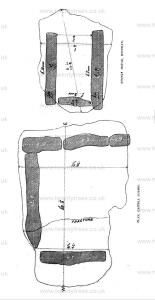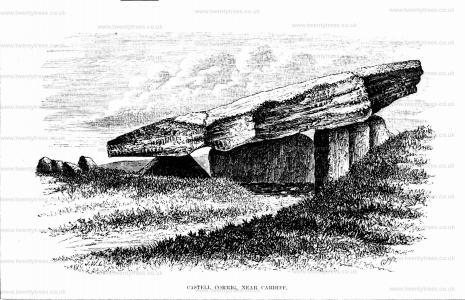Archaeologia Cambrensis 1875 Page 171
Archaeologia Cambrensis 1875 Page 171 is in Archaeologia Cambrensis 1875.
On The St. Lythan's And St. Nicholas' Cromlechs And Other Remains, Near Cardiff.
In No. 17 (4th series) of this Journal, a short notice is given on these two megalithic structures, but as the dimensions differ somewhat from those taken by myself, I beg to send you drawings and ground plans of them, as also of other remains near Cardiff. They are reduced to the same scale to show their comparative sizes.
Unfortunately their contents were thrown out years ago, and no record of them kept, at least so far as I can ascertain; and as any facts connected with them may be interesting to archaeologists, I send the following from my notes.
Not being satisfied with merely planning and sketching them, we were anxious to ascertain whether what had been thrown out from the interior resembled in any way the contents of similar localities examined elsewhere by myself and brothers; we therefore grubbed about amongst the debris of stones, etc., outside the St. Nicholas cromlech [Map], and soon discovered fragments of human teeth and unburnt bones, with portions of rude pottery, thus proving that its original use was the same everywhere, i. e., for the express purpose of burying the dead within, then covering them afterwards with a mound of earth or small stones, for the double purpose of concealing them, and marking the last resting place of departed chiefs or friends. There is no doubt whatever, that, whether we see cromlechs covered with a mound or denuded of their coverings, they were all sepulchral chambers and all originally covered by a mound or tumulus. Those we now find uncovered have been exposed to view by subsequent searchers after treasure, or the ground has in later times been removed for agricultural purposes.
If we take up those charming poems of Ossian, which date back to the third century, we continually find allusions made to the "mounds" and "gray stones" that mark the last resting places of departed warriors, thus: " If fall I must in the field, raise high my grave, Vinvela. Gray stones and heaped up earth shall mark me to future times; when the hunter shall sit by the mound and produce his food at noon,' Some warrior rests here,' he will say, and my fame shall live in his praise". Again, " Their green tombs are seen by the mariner when he bounds on the waves of the north".1 The greatest length of the St. Nicholas cromlech capstone is 22 ft. 9 in. by 15 ft. 8 in. wide, and 3 ft. 6 in. thick, supported by three props at the east end; the first measures 5 ft. 5 in. in height, by 2 ft. 9 in. wide; the second 3 ft. 5 in. by 6 ft. 8 in. wide; the third 3 ft. 4 in. by 4 ft. 10 in. wide. The western end is supported by one prop 11 ft. 8 in. wide by 2 ft. 10 in. high; on the north there is but one prop 13 ft. 8 in. wide by 5 ft. high. The prop or props, which no doubt completed this chamber on the south side, have long since been removed. The remains of the original mound are visible all round.
Note 1. Surely the poems of Ossian, manufactured in the last century, cannot have the slightest historical value.—Ed. Arch. Camb.


When visiting this cromlech, which is on the Dyffryn estate, in the parish of St. Nicholas, in a small wood close to the farm occupied by Mr. Jenkins, distant from Cardiff about six miles on the road to Cowbridge, I was much struck with the name given to it by some children we found playing round these " big stones". On my asking one of them what they called them, he replied, " Castell Corrig". Some years ago, when examining the numerous Celtic remains of Brittany, I found the same name given to many of the cromlechs thei'e, Corrig meaning a fairy in the Breton language. The " Butte de Cesar" tumulus, which is 33 ft. in height, to be seen near the village of Locmariaquer, close to the sea shore at the entrance to the Gulf of the Morbihan, is known to the native peasantry as Manne'-er-h'roek, or Montague de la lee. The French call them "Creux des fees" and " roches aux fees". In England we call them "Fairies' Hole" or "Cave." In the Channel Islands they are also called by the same names, and also "Pouquelaye", "Pouque", meaning a fairy, hence, no doubt, the name given by the immortal Shakespeare to "Puck", one of the characters in his Midsummer Night's Dream. A few yards from this spot, to the north-west in the same wood, are to be seen several stones showing their heads above ground which appear to me to be props belonging to another cromlech. There are also several large blocks in the fields and hedges close by, which I think must have belonged to other similar structures.
The orientation of the Castell Corrig cromlech is nearly east and west, that is to say, the capstone, which is long, inclines to the west, and not to the east, as in most other examples.
About three quarters of a mile from this spot, following the road southwards to St. Lythan's, you arrive at a cross road, close to which, on turning to the left and near to a small cottage, stands in all its grandeur in the field above the fine megalithic structure of St. Lythan's, very good drawings of which are given in No. 17 of this Journal.
Here, too, I also found children playing; on my asking them what they called these " big stones", they replied "Stoney House". The name given in the Ordnance map of the locality is Maes y Felin.
Its dimensions are, height to top of capstone 11 ft. 8 in., length 14 ft. 8 in. by 10 ft., and 2 ft. 6 in. in thickness; height of south prop 9 ft. 11 in. by 11 ft. 6 in., and 1 ft. 6 in. in thickness; the north prop measures 9 ft. 10 in. high by 10 ft. wide, and 1 ft. 9 in. thick; the western prop is 7 ft. 6 in. high by 4 ft. 8 in. wide.
Amongst the debris thrown out from the interior, years ago, we found, as at St. Nicholas, human remains unburnt and coarse pottery. It matters very little which direction wre take over the Welsh hills, there we find cromlechs, tumuli or cairns, and camps. Archaeologists have, therefore, much to interest them besides the ruined abbeys and castles nestling on such favoured spots, and strange as it may appear, there are always fairy tales and ghost stories connected with them; some, though fully believed in by the inhabitants of those localities, are often of the most absurd character; in fact, the more ridiculous they are the more they are believed in.
Master "Puck" plays his part well, and tradition records many of his wonderful pranks even in this neighbourhood. In 1851 an amusing pamphlet was written as a prize essay, entitled "Pwka'r Trwyn", or the celebrated Mynyddislwyn sprite, by the late Mr. D. Rhys Stephen. The Trwyn is a farm on the left hand side of the Valley of the Gwyddon, as you ascend it from Abergwyddon, and near the top of it. It is reported that a servant girl, who attended to the cattle belonging to this farm, was in the habit of taking out a bowl of fresh milk and a slice of white bread, which she placed on a certain spot for "Master Pwka", but one evening she ate the white bread and drank the milk, and substituted coarse bread and very inferior beverage. The basin was returned with the meal untouched, and the next time the girl passed the lonely spot she felt herself taken hold of, she fancied, by human hands under the arm pits, and no very sparing castigation inflicted upon her, with a clear indication, in plain Welsh, of the nature of her offence, with appropriate warnings against its repetition. This is thoroughly believed in there to this day.
A word or two on these sometimes mischievous and at other times good-natured sprites.
Puck, Poke, Poake, Pouque, Powka, Pucca, Pixie, Pixam, Pincke, Picke, Patch, Elf, Hob, Hobgoblin, Hobthrush, etc., and a variety of other names, are all given to the busy everywhere to be heard of sprites. Some are supposed to haunt woods, some houses, others the tops of hills, certain valleys, ruined buildings, and even the sea coast; in every country we hear of them. Many villages, hills, meadows, and ruins, bear evidences of Puck's visits, such as Upper and Lower Puck Hill, Puck Meadow, Powk House, Puckwell, Puckington, Puck's Pock near Howth, and Puck Castle, a romantic ruin in the county of Dublin, Pixie's Cave at Dartmoor, Pix Hill, Herefordshire, etc., Cwm Pucca, the Devil's Bridge in South Wales, and the celebrated Pwka'r Trwyn, well known also for his pranks at Pant y Gaseg near Pontypool.
The Dutch "spook", the German "spuck", the Swedish, "spoke", and the Danish " spogelese", mean precisely the same thing; thus the Germans and Swedes say, "Es spuckt im hause", and "Det spokar i hauset", for "the house is haunted". Then we have the puff-ball, or Puck-ball or Puck-fist, and "fairy rings"; the "little folks" are known to have a great liking for the fungus or mushroom tribe, as Drayton in his Nymphidia says:
Continues ...